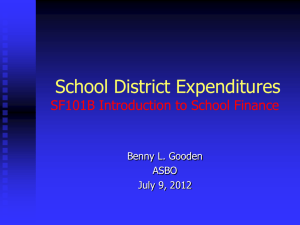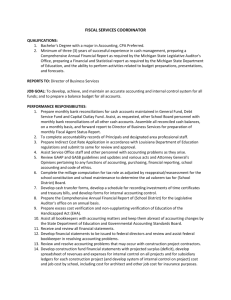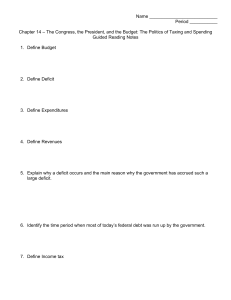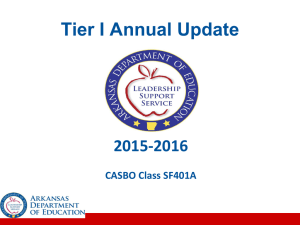School Finance-Expenditures - Arkansas Association of Educational
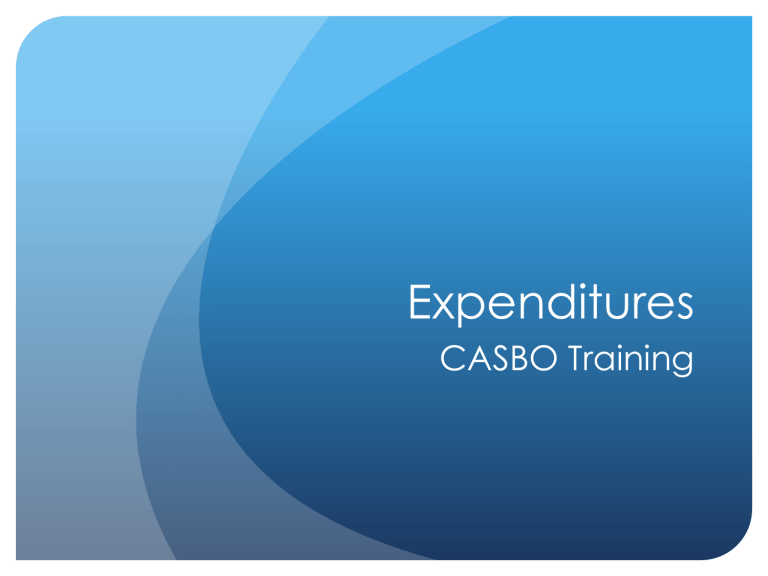
Expenditures
CASBO Training
Values and Money
We spend our TIME and our MONEY on what we VALUE.
Why are you here?
ASBO Certification
Increase personal knowledge
Tier 1 Requirement
Tier 1 annual update.
Expenditures
What are the major categories of expenditures in a typical district?
Salaries & Benefits
Supplies/Equipment
Services
Capital Outlay
Debt Service.
What is the proportion of each to the whole operating budget?
Salaries & Benefits
Supplies/Equipment
Services
Capital Outlay
Debt Service.
Salaries/Benefits
Salaries
Contracted wages
Time sheet pay
Benefits Calculations
FICA – 6.2% (maximum salary $113,700 in 2013)
Medicare – 1.45%
Teacher Retirement – 14%
=
21.65%
Other benefits provided by the district for all certified and/or classified employees
Health - $131, moving to $150 in January
Dental, Disability Insurance
Worker’s Compensation
Unemployment
For estimating purposes, total @25%.
Will vary slightly by district.
Salary Essentials
Approved Salary Schedules for various groups of employees
Approved way for paying for extra assignments
Contracts issued in a timely fashion
Educational Increments
Savings from retirees vs. new hires
Severance Issues
Multi-year impact of salary policy
Educational Excellence Trust Fund compliance.
Supplies/Equipment
Difference is important as it relates to accounting and the inventory of fixed assets
Inventory vs. fixed asset
Inventory – a detailed list of items in stock
Fixed asset - Any tangible asset with a life of more than two years used in an entity's operations.
Services
Professional Services
Property Services
Other Services.
Professional Services
Professional and Consultant Services are exempt from bidding
Accounting
Engineers
Architects
Legal
Medical
Information/Technology
Appraisal
Do they give advice or do they supply a product?
Generally, are they licensed or recognized in some way by a certifying professional organization?
Property Services
Utilities
Construction Services
Lawn care
Cleaning services
Rental.
Other Services
Transportation
Insurance
Advertising.
Capital Outlay
Purchases/Construction of a fixed asset of such a significant amount that it is considered unusual and substantial in relation to the overall budget of the district.
Debt Service
Payment is in three parts
Principal
Interest
Fees
Debt Schedule
Debt Service
Your Fiscal Agent
Taxable vs. Non-Taxable Bonds
Arbitrage - Attempting to profit by exploiting price differences of identical or similar financial instruments on different markets or in different forms.
Accounting Procedures
ACCOUNTING
The definition of accounting is “ the system of recording and summarizing business and financial transactions and analyzing, verifying, and reporting the results.
”
ACCOUNTING -
Why should I care about accounting for money?
It is the right thing to do.
People lose their job quicker over money and sex than anything else.
You have a responsibility to your public.
You have a responsibility to your kids.
Basis of Accounting
Establishes point-in-time when revenues or expenditures and related assets and liabilities are recognized in district accounts and reported in financial statements
Determines timing with which the accounting system recognizes transactions.
Basis of Accounting
Cash Basis – Recognized when cash is received or disbursed
Accrual Basis – Measures financial position based on economic resources and obligations
Cash Basis
Revenue recorded when cash is received
Expenses recorded when cash is paid
Financial condition measured b cash balance
Receivables, payables or accrued items are not recognized.
Accrual Basis
Revenues are recognized when earned – regardless of when received
Expenses are recognized when incurred – regardless of when paid
Economic status reflects resources and obligations – regardless of cash flow timing.
Accounting for Expenditures
You will spend money.
How will you know how much you are spending and what you spent it for?
How can you report that information out to your Board and to your Public?
How can you prepare for the annual visit of your auditor?
Evolution of Account
Classifications
Handbook II, Financial Accounting for Local and
State School Systems: Standard Receipt and
Expenditure Accounts, 1957
Handbook II Revised, Financial Accounting:
Classification and Standard Terminology for Local
and State School Systems, 1973.
Account Classification
Standards-Present Edition
Handbook II R2- 1990
Reflects changes and clarifications in generally accepted accounting principles (GAAP)
Financial Accounting for Local and State School Systems.
2003 Edition (NCES)
NCES Revised Edition published June, 2009. http://nces.ed.gov/ppubsearch/pubsinfo.asp?pubid2009325
State Accounting Systems (ADE, etc.) adapt Handbook II
R2 for use by local school districts
Access on
APSCN site
Interest relative to Handbook IIR 2 is widespread
Account coding is required to reveal:
Athletic expenditures
Student transportation
District administration
School administration
Instructional facilitators
Supervisory aides
Substitutes
Property Insurance
Act 1006
Requires gathering information on these expenditures:
Student growth
Declining enrollment
Special education catastrophic occurrences
Special education services
Technology grants
Debt service supplement
General facilities
Distance learning
Gifted and talented
Do it Right…or Pay the Price!
Act 1006 provides for ADE to publish rules to identify error rates by local schools in reporting and provides that fines or other penalties may be assessed.
THE BUDGET UNIT
The 21 digit number that indicates what fund will pay, what kind of expenditure, what cost-center, what type of goods or services the expenditure is.
It provides the detail of the expenditure.
It also provides a way to report and analyze the expenditures of a district and ultimately the state.
THE BUDGET UNIT
Six sections of the budget unit:
1000-1140-049-000-00 61110 – Certified Salary
2000-1120-042-000-00 62210 – Certified Social Security
2281-1105-040-987-00 66100 – Supplies for early childhood
2000-2134-005-000-79 65800 – Nurse ’ s travel budget
What is this budget strip used for?
2281-1105-040-987-00 66100
FUND
1000 – Teacher Salary Fund
2000 – Operating Fund
3000 – Building Fund
4000 – Debt Service Fund
5000 – Capital Outlay Fund
6000 – Federal Funds
7000 – Activity Funds
8000 – Food Service Fund
9000 – Fixed Assets
2 281-1105-040-987-00 66100
Source of Fund - SOF
Federal Funds
Activity Funds
Grants
Categorical Funds
223 – Professional Development
275 – ALE
276 – ELL
281 – NSLA
Facilities Funding
2 281 -1105-040-987-00 66100
Function
1000 – Instruction
2000 – Support Services
3000 – Operation of Non-Instructional Services
4000 – Facilities acquisition and Construction
4610 – Building Acquisition and Construction
4630 – Athletic Building Acquisition and
Construction
5000 – Other (debt)
22811105 -040-987-00 66100
Location
Normally, it is the last three digits of the building ’ s
LEA number. Can be a building number designated by the district for non-instructional buildings.
??-??-040
2281-1105040 -987-00 66100
Program
Used to further identify the specific use of the funds to be expended.
Districts may use 900-999
Special Ed – 200
Athletics - 115
2281-1105-040987 -00 66100
Subject
Used to provide even more detail on the expenditure.
The State can use both Program and Subject codes at their discretion.
Currently, the State does not use this portion of the budget unit.
2281-1105-040-98700 66100
Object
Sometimes called the Account. Tells us what was purchased
2281-1105-040-987-00 66100
61000 – Salaries
61100
61110 – Certified Salaries
61120 – Classified Salaries
62000 – Benefits
62200
62210 – Certified Social Security
62220 – Classified Social Security
Object
63000 – Purchased Professional and Technical Services
63370 – Architect
64000 – Purchased Property Services
64240 – Lawn Care
65000 – Other Purchased Services
65210 – Property Insurance
65310 – Telephone
Object
66000 – Supplies and materials
66100 – General Supplies
66410 – Textbooks
67000 – Property
67100 – Land and improvements
67200 – Buildings
68000 – Other Objects
68830 – Property Tax
69000 – Other
69310 – Transfer to Teacher Salary Fund
The Budget Strip
2281-1105-040-987-00 66100
Fund/Source of Fund
Function
Location
Program
Subject
Object
Determining Which Coding to Use
Accounting is both a science and an art.
I could give you an invoice and we could come up with 10 different ways to code that invoice.
Pay attention to what the Department says to do.
Be honest.
Be consistent.
Ask other people ’ s opinion.
It really does matter.
Management Strategies For
Expenditure
Establish Procedures
Purchase Order (P.O.) Process
Receipts/Reimbursements
Do you have a written purchasing procedure?
Do you have a written travel reimbursement procedure?
Frequent Monitoring and Reporting
Ask for reports periodically.
Report to your Board frequently.
Management Strategies For
Expenditure
Learn how to operate “Excel”
Track important numbers
Ending Balance
Total Revenue
Total Expenditures
Property Tax Assessments
Student ADM
Be cautious about adding new personnel.
Management Strategies For
Expenditure
Control of Organizational Chart of Accounts
Structure
A single person should control the chart
Internal Controls
Systems of cross checking and balancing to minimized
Segregation of Duties
A key operational control to ensure that one key operational function
Security of your unwritten checks and signature stamps.
Targets of “ Fiscal Distress ”
Declining balance to jeopardize fiscal integrity of a school district
Act or violation to jeopardize fiscal integrity
Any other fiscal condition of a school district deemed to have a material detrimental negative impact on the continuation of educational services by that school district.
Potential “ acts or violations ”
Material failure to…
Properly maintain school facilities
Violation of local, state, or federal fire, health or safety code provisions
Violation of local, state, or federal construction code provisions or law
Material state or federal audit exceptions
Failure to provide timely and accurate legallyrequired financial reports to ADE, Division of
Legislative Audit, General Assembly or IRS
Other ways to violate….
Materially…
Insufficient funds to cover payroll, salary, employment benefits or legal tax obligations
Failure to meet legally binding minimum teacher salary schedule obligations
Failure to comply with state law governing purchasing or bid requirements
Default on any school district debt obligations
Discrepancies between budgeted and actual school district expenditures
Other material ways…
Materially….
Failure to comply with audit requirements of 6-20-301
Failure to comply with any provision of the
Arkansas Code that specifically places a school district in fiscal distress based on noncompliance.
What Happens then?
Finding by State Board of Education
Publication of notices
Limited rights of appeal
Submit plan to ADE within 10 days
ADE oversight of plan and implementation
Required ADE approval of plan
ADE technical assistance
ADE recommendations/mandated staffing and fiscal practices.
Other ADE actions…
Replace superintendent
Suspend local board authority
Transfer authority to new board/superintendent
Required reporting requirements
ADE monitoring of accounts and operations
Training required for district board members and employees
.
Final Action
Consolidation
Annexation
Reconstitution
Other appropriate action
The Legal Fund Balance
Restricted Fund Balance
Categoricals, vocational, adult ed., etc.
201 Adult Basic Education
202 Adult General Education
203 Workplace Adult Education
205 Other Adult Education
212 Isolated Funding
223 Professional Development
275 Alternative Learning Environment
276 English Language Learners
281 National School Lunch Act
293 Secondary Workforce Centers
320 Adult Center Support
323 Short-term Adult Skill Training
386 Pulaski County Magnet School
387 M-to-M Revenue
388 Magnet & M-to-M Transportation
391 Public School Facilities Escrow
401 Academic Facilities-Immed Rep
402 Academic Facilities-Catastrophic
403 Academic Facilities-Transitional
404 Academic Facilities-Partnership
Bal Sheet 01915 Deposits-Paying Agents(QZAB)
The Legal Fund Balance
Unrestricted Fund Balance is used to determine fiscal distress.
It is your operating balance minus restricted funds.
What about balances in restricted funds?
NSLA
ELL
ALE
Professional Development
Federal Funds
Spending Requirements for Categorical
Funds
Act 1220 of 2011
At least 85% of NSLA Funds must be spent
Transfer authority among categories is granted
Commissioner may grant waivers
Balance in categorical funds shall not exceed 20% of annual allocation
Provisions for 10% annual reduction required
Failure to comply results in reduction in future
NSLA funding.
etc
Handbook IIR 2 also includes instructions on recording
& classification of fixed assets
Journal Entries.
etc
Make your Auditor happy
Be detail-oriented about your finances.
Revenue low expenditures high,
What is your favorite color?
$ $
Key Word for staying in the black in your district:
Thank you!
Email me
–
murryg@conwayschools.net
Call me
–
501-450-4800
